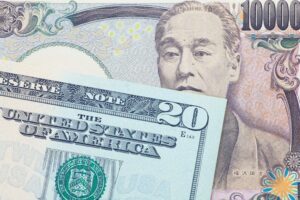
- Gold price struggles to gain any meaningful traction and oscillates in a range on Friday.
- Expectations that the Fed is done with its policy-tightening campaign act as a tailwind.
- Rebounding US bond yields, reviving USD demand and a positive risk tone cap gains.
- Traders also seem reluctant to place directional bets ahead of the crucial US NFP report.
Gold price (XAU/USD) extends its sideways consolidative price move for the fourth successive day and remains confined in a range through the early European session on Friday. Traders now seem reluctant to place aggressive bets and prefer to wait on the sidelines ahead of the closely-watched US monthly employment details, popularly known as the Nonfarm Payrolls (NFP) report, due later today. Any further signs of a weaker labor market will reaffirm dovish Federal Reserve (Fed) expectations, which, in turn, should weigh on the US Dollar and provide a fresh boost to the commodity.
In the runup to the key data risk, the USD is back in demand on the back of a further recovery in the US Treasury bond yields. This, along with a generally positive risk tone, turns out to be a key factor acting as a headwind for the Gold price. That said, firming expectations that the Fed will not raise interest rates again and may start easing its policy by the first half of 2024 continue to lend some support to the non-yielding yellow metal. Furthermore, a darkening global economic outlook (particularly in China) and geopolitical tensions should limit the downside for the XAU/USD.
Daily Digest Market Movers: Gold price lacks firm near-term direction amid mixed cues ahead of US NFP
- The market conviction that the Federal Reserve is done with its policy-tightening campaign and may start cutting rates in 2024 continues to act as a tailwind for the Gold price.
- The US JOLTS Job Openings data and the ADP report released earlier this week pointed to a cooling in the US labor market and reaffirmed dovish Fed expectations.
- According to the CME group's FedWatch Tool, traders are currently pricing in over a 60% chance of a 25 bps Fed rate cut move as early as the March 2024 policy meeting.
- The yield on the benchmark 10-year US government bond moves away from a three-month low and lends some support to the US Dollar, capping gains for the non-yielding metal.
- The lack of any further escalation in the Middle East tensions and the overnight risk-on rally in the US equity markets also contributes to keeping a lid on the safe-haven XAU/USD.
- Traders now look to the closely-watched US monthly employment details for more cues about labor market conditions and the timing when the Fed could begin loosening policy.
- The headline NFP print is expected to show that the US economy added 180K jobs in November, up from 150K in the previous month, and the unemployment rate held steady at 3.9%.
- The focus will also be on Average Hourly Earnings data, which is expected to have risen by 0.3% during the reported month and by 4% over the past 12 months through November.
- Any negative surprise could force the Fed to soften its hawkish tone in the coming months and benefit the commodity amid worries about a global economic downturn and geopolitical tensions.
Technical Analysis: Gold price extends its consolidative price move, bullish potential seems intact
From a technical perspective, the recent range-bound price action witnessed over the past four days constitutes the formation of a rectangle on short-term charts. This points to a consolidation phase before the next leg of a directional move. Meanwhile, the lower boundary of the said trading band now coincides with the 100-period Simple Moving Average (SMA), currently pegged around the $2,015-2,014 area. This, in turn, should act as a key pivotal point ahead of the $2,000 psychological mark. A convincing break below the latter could drag the Gold price to the $1,977-1,976 horizontal support. The corrective decline could get extended further towards the very important 200-day SMA, near the $1,950 area.
On the flip side, the $2,038-2,040 region, representing the top end of the multi-day-old trading range, might continue to act as an immediate barrier. A sustained strength beyond will be seen as a fresh trigger for bullish traders amid the occurrence of a golden cross, with the 50-day Simple Moving Average rising above the 200-day SMA. Moreover, oscillators on the daily chart are holding comfortably in the positive territory and are still far from being in the overbought zone. This, in turn, suggests that the path of least resistance for the Gold price is to the upside. In the meantime, any subsequent move up might confront some resistance near the $2,045 level ahead of the $2,071-2,072 area and the $2,100 round figure.
US Dollar price today
The table below shows the percentage change of US Dollar (USD) against listed major currencies today. US Dollar was the weakest against the Japanese Yen.
| USD | EUR | GBP | CAD | AUD | JPY | NZD | CHF | |
| USD | 0.00% | 0.14% | -0.10% | -0.20% | -0.28% | 0.18% | -0.13% | |
| EUR | -0.01% | 0.13% | -0.12% | -0.22% | -0.30% | 0.15% | -0.13% | |
| GBP | -0.14% | -0.14% | -0.27% | -0.36% | -0.46% | 0.01% | -0.26% | |
| CAD | 0.11% | 0.10% | 0.25% | -0.10% | -0.17% | 0.28% | -0.02% | |
| AUD | 0.20% | 0.21% | 0.35% | 0.10% | -0.08% | 0.38% | 0.09% | |
| JPY | 0.28% | 0.30% | 0.43% | 0.17% | 0.07% | 0.47% | 0.16% | |
| NZD | -0.17% | -0.17% | -0.01% | -0.28% | -0.38% | -0.47% | -0.28% | |
| CHF | 0.12% | 0.13% | 0.28% | 0.00% | -0.10% | -0.17% | 0.27% |
The heat map shows percentage changes of major currencies against each other. The base currency is picked from the left column, while the quote currency is picked from the top row. For example, if you pick the Euro from the left column and move along the horizontal line to the Japanese Yen, the percentage change displayed in the box will represent EUR (base)/JPY (quote).
Nonfarm Payrolls FAQs
Nonfarm Payrolls (NFP) are part of the US Bureau of Labor Statistics monthly jobs report. The Nonfarm Payrolls component specifically measures the change in the number of people employed in the US during the previous month, excluding the farming industry.
The Nonfarm Payrolls figure can influence the decisions of the Federal Reserve by providing a measure of how successfully the Fed is meeting its mandate of fostering full employment and 2% inflation.
A relatively high NFP figure means more people are in employment, earning more money and therefore probably spending more. A relatively low Nonfarm Payrolls’ result, on the either hand, could mean people are struggling to find work.
The Fed will typically raise interest rates to combat high inflation triggered by low unemployment, and lower them to stimulate a stagnant labor market.
Nonfarm Payrolls generally have a positive correlation with the US Dollar. This means when payrolls’ figures come out higher-than-expected the USD tends to rally and vice versa when they are lower.
NFPs influence the US Dollar by virtue of their impact on inflation, monetary policy expectations and interest rates. A higher NFP usually means the Federal Reserve will be more tight in its monetary policy, supporting the USD.
Nonfarm Payrolls are generally negatively-correlated with the price of Gold. This means a higher-than-expected payrolls’ figure will have a depressing effect on the Gold price and vice versa.
Higher NFP generally has a positive effect on the value of the USD, and like most major commodities Gold is priced in US Dollars. If the USD gains in value, therefore, it requires less Dollars to buy an ounce of Gold.
Also, higher interest rates (typically helped higher NFPs) also lessen the attractiveness of Gold as an investment compared to staying in cash, where the money will at least earn interest.
Nonfarm Payrolls is only one component within a bigger jobs report and it can be overshadowed by the other components.
At times, when NFP come out higher-than-forecast, but the Average Weekly Earnings is lower than expected, the market has ignored the potentially inflationary effect of the headline result and interpreted the fall in earnings as deflationary.
The Participation Rate and the Average Weekly Hours components can also influence the market reaction, but only in seldom events like the “Great Resignation” or the Global Financial Crisis.
- SEO Powered Content & PR Distribution. Get Amplified Today.
- PlatoData.Network Vertical Generative Ai. Empower Yourself. Access Here.
- PlatoAiStream. Web3 Intelligence. Knowledge Amplified. Access Here.
- PlatoESG. Carbon, CleanTech, Energy, Environment, Solar, Waste Management. Access Here.
- PlatoHealth. Biotech and Clinical Trials Intelligence. Access Here.
- Source: https://www.fxstreet.com/news/gold-price-struggles-for-a-firm-near-term-direction-eyes-us-nfp-report-for-fresh-impetus-202312080410
- :has
- :is
- :not
- :where
- $UP
- 000
- 1
- 100
- 12
- 12 months
- 2%
- 2% Inflation
- 2024
- 25
- 30
- 32
- 35%
- 41
- a
- About
- above
- Act
- acting
- Action
- added
- adp
- ADP report
- again
- against
- aggressive
- ahead
- along
- also
- Amid
- an
- analysis
- and
- Animate
- any
- ARE
- AREA
- around
- AS
- At
- average
- await
- away
- back
- BAND
- barrier
- base
- BE
- before
- begin
- being
- below
- Benchmark
- benefit
- Bets
- Beyond
- bigger
- bond
- Bond yields
- boost
- Box
- Break
- Bullish
- Bureau
- bureau of labor statistics
- but
- buy
- by
- Campaign
- CAN
- cap
- Cash
- Chance
- change
- Changes
- Chart
- Charts
- China
- CME
- CME Group
- coincides
- Column
- combat
- come
- coming
- Commodities
- commodity
- compared
- component
- components
- conditions
- consolidation
- content
- continue
- continues
- contributes
- conviction
- Correlation
- could
- crisis
- Cross
- crucial
- currencies
- Currency
- Currently
- Cut
- cutting
- daily
- data
- day
- Days
- decisions
- Decline
- deflationary
- Demand
- details
- Digest
- direction
- directional
- displayed
- Dollar
- dollars
- done
- Dovish
- downside
- DOWNTURN
- due
- during
- each
- Earlier
- Early
- earn
- Earning
- Earnings
- easing
- East
- Economic
- economic downturn
- economy
- effect
- either
- employed
- employment
- end
- ends
- equity
- Equity Markets
- escalation
- EUR
- Euro
- European
- events
- example
- excluding
- expanded
- expectations
- expected
- extended
- extends
- factor
- Fall
- FAQ
- far
- farming
- Fed
- Federal
- federal reserve
- Figure
- Figures
- financial
- financial crisis
- Find
- Firm
- First
- Flip
- Focus
- For
- Force
- formation
- fostering
- four
- Fourth
- fresh
- Friday
- from
- full
- further
- Furthermore
- Gain
- Gains
- generally
- geopolitical
- get
- Global
- Global Economic
- global financial
- Global Financial Crisis
- Gold
- gold price
- Golden
- golden cross
- Government
- Group
- Half
- hand
- Have
- Hawkish
- headline
- Held
- helped
- High
- High inflation
- higher
- holding
- Horizontal
- HOURS
- How
- HTTPS
- if
- immediate
- Impact
- important
- in
- industry
- inflation
- Inflationary
- influence
- interest
- Interest Rates
- investment
- IT
- ITS
- Japanese
- Japanese Yen
- Job
- Jobs
- jobs report
- JOLTS Job Openings
- jpg
- keeping
- Key
- key factor
- known
- labor
- labor market
- Lack
- later
- least
- left
- LEND
- less
- Level
- like
- LIMIT
- Line
- Listed
- Look
- Low
- lower
- major
- mandate
- map
- March
- March 2024
- mark
- Market
- market conditions
- market reaction
- Markets
- May..
- mean
- meaningful
- means
- meantime
- Meanwhile
- measure
- measures
- meeting
- metal
- Middle
- Middle East
- might
- mixed
- module
- Monetary
- Monetary Policy
- money
- Month
- monthly
- months
- more
- Moreover
- most
- move
- Movers
- moves
- moving
- moving average
- Near
- negative
- next
- nfp
- Nonfarm
- Nonfarm Payrolls
- November
- now
- number
- occurrence
- of
- on
- ONE
- only
- openings
- or
- Other
- Ounce of Gold
- out
- over
- overnight
- part
- participation
- particularly
- past
- path
- Payrolls
- pegged
- People
- percentage
- perspective
- phase
- pick
- picked
- pivotal
- Place
- plato
- Plato Data Intelligence
- PlatoData
- Point
- points
- policy
- positive
- potential
- potentially
- prefer
- previous
- price
- PRICE ACTION
- pricing
- probably
- provide
- providing
- psychological
- quote
- raise
- rally
- range
- Rate
- Rates
- reaction
- reaffirm
- reaffirmed
- recent
- recovery
- region
- relatively
- released
- remains
- report
- Reported
- represent
- representing
- requires
- Reserve
- Resistance
- result
- Risen
- rising
- Risk
- round
- ROW
- s
- Said
- seem
- seems
- seen
- seldom
- session
- short-term
- should
- show
- Shows
- side
- sideways
- Signs
- Simple
- SMA
- some
- specifically
- Spending
- start
- starts
- statistics
- staying
- steady
- Still
- stimulate
- strength
- Struggles
- Struggling
- subsequent
- Successfully
- Suggests
- support
- Supporting
- surprise
- sustained
- table
- Tailwind
- Technical
- tends
- tensions
- territory
- than
- that
- The
- the Fed
- their
- Them
- therefore
- they
- this
- this week
- Through
- times
- timing
- to
- today
- TONE
- tool
- top
- towards
- traction
- Traders
- Trading
- treasury
- trigger
- triggered
- TURN
- turns
- typically
- unemployment
- unemployment rate
- Upside
- us
- US bond yields
- US Dollar
- US Dollars
- US economy
- US equity markets
- us government
- US JOLTS Job Openings
- us NFP
- US Treasury
- USD
- usually
- value
- very
- vice
- wait
- was
- weaker
- week
- weekly
- weigh
- when
- which
- while
- will
- with
- within
- witnessed
- Work
- XAU/USD
- yellow
- Yen
- Yield
- yields
- you
- zephyrnet












